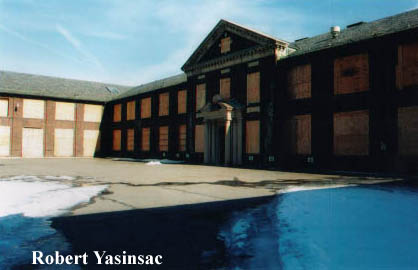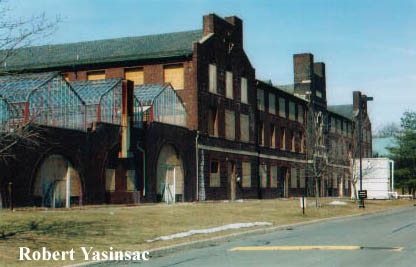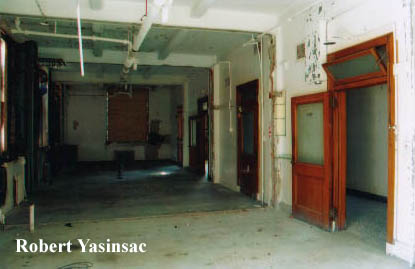For Plant Research
YONKERS, NY

Boyce Thompson Institute, West Front. Yonkers, NY.
February 19, 2001

Boyce Thompson Institute, West Front. Yonkers, NY.
February 19, 2001
NOTE: The Boyce Thompson Institute Building in Yonkers is proposed for commercial redevelopment. Please read the updates at the bottom of this page to follow the progress of the development (June 12, 2015).
"There will be two hundred million people in this country pretty soon. It's going to be a question of bread, of primary food supply. That question is beyond politicians and sociologists. I think I will work out some institution to deal with plant physiology, to help protect the basic needs of the 200 million. Not an uplift foundation, but a scientific institution dealing with definite things, like germination, parasites, plant diseases, and plant potentialities."
-William Boyce Thompson, circa 1919
And thus began
the initiative by international mining financier and Yonkers resident to
build the Boyce Thompson Institute for Plant Research
(BTI), “a private not-for-profit organization dedicated to the study of
plants and associated organisms for the betterment of society” (http://www.yonkershistory.org/
8_2_2.html -- John D'Agnillo).” Built in 1924 across the Street from Mr.
Thompson’s country estate Alder
Manor, the Georgian Revival building was designed by architect Frank
Arnold Colby and built by the J. G. White Engineering Corporation, engineers
and contractors, of 43 Exchange Place, New York City. It is constructed
of reinforced concrete with a Flemish Bond brick veneer and is attached
to a series of greenhouses on the south end, which were part of the original
construction. The north half of the building was built in 1930, and greenhouses
and related structures to the West of the building were built and or modified
in subsequent years. (Many thanks to Dewayne Torgeson, Retired, Boyce Thompson
Institute, for supplying the information I have copied here.)

BTI, from southeast, showing greenhouses.
February 19, 2001
The idea for
the Plant Research facility came about during a visit to Russia in 1917,
where Thompson was part of a Red Cross mission sent by President Woodrow
Wilson to keep Russia in World War I and to encourage the formation of
a democratic government, under the guise of a relief mission. Thompson
witnessed much suffering and starvation and the inability of a social democratic
government to take care of its own people. Of course Russia limped out
of the war, and its own Civil War ended in Communist takeover. Upon return
from his experience in Russia, Thompson was convinced “that agriculture,
food supply, and social justice are linked. World political stability in
the future, he prophesied, would depend on the availability of adequate
food. This conviction, along with his faith in science, helped to shape
his next philanthropic project” (http://bti.cornell.edu/ar98/history/hist1.htm).
The Boyce Thompson Institute continued important research and innovation
at its Yonkers home for over 50 years. The pollution of the Hudson River
spawned extensive research into the subject, and in 1977 the BTI, under
the project leadership of Edward H. Buckley, published An Atlas of the
Biologic Resources of the Hudson Estuary. However, just over a year
later, the BTI moved to Cornell University, as cooperation with the educational
institution offered advantages into research opportunities, plus the fact
that property taxes in Yonkers had been high once the area became urbanized. The
Boyce Thompson Institute today operates as an independent organization in
cooperation with Cornell University.

Only in the winter of
2000/2001 did this building come to my attention, as it did not appear to be vacant
before. All of the windows frames were removed and boarded up; the greenhouses may not have been used since 1978. The ornamental raised
beds west of the facility are just as empty. At one point the BTI was surrounded
on three sides by the Hudson River Country Club, its now-demolished clubhouse
stood to the south of the BTI complex. Much of the country club acreage
is now an office park. The interior of the BTI is completely devoid of
artifacts and furnishings, and many walls have been removed or stripped
down. The north wing is interesting as it is one giant empty two-story
room, this probably being where the library stacks were located.
The Boyce Thompson
Institute was leased out and actively used as late as 1997, and was acquired by the
City
of Yonkers / Board of Education in 1999. Work required,
prior to re-use of the building, was undertaken. This work included abatement of
potentially hazardous materials (a common process when adaptively-reusing older
buildings); the removal of windows and the stripping of interior wall
finishes left the building looking a bit unkempt. Several proposals for reuse of
the site came and went after Yonkers decided not to use the site for a school,
all the while the City failed to properly maintain the building - the plywood
boards covering the windows were frequently torn off and not replaced. In 2004,
Weinberg Brothers and Associates announced plans to reuse the site. That process
is ongoing as of winter 2007 and will be covered here in the "Updates"
section below.
|
|
|
Much of the information came from this website:
http://bti.cornell.edu/
- The official Boyce Thompson Institute web site.
http://bti.cornell.edu/history.php
- Direct Link to BTI History
More Boyce Thompson Institute Photo Galleries
March 24, 2005:
Exteriors
Interiors
Greenhouses
UPDATE: JUNE 12, 2015
Simone Development Companies has broken
ground at the Boyce Thompson Institute site for redevelopment of the
property. The main building will be preserved but the greenhouses will be
demolished. The project will feature an "85,000-square-foot mixed-use
complex with office and medical space, restaurants, banking and retail stores"
including an "a new 18,000-square-foot addition." The project should
be completed in early 2017.
UPDATE: SEPTEMBER 17, 2010
Westfair Online reported
on the proposed development plans for the Boyce Thompson Institute site
this past January.
UPDATE: APRIL 12, 2007
On April 10, the Yonkers City Council passed a resolution authorizing the Mayor
of Yonkers to execute a contract for the sale of the Boyce Thompson Institute property
on North Broadway to Weinberg B T LLC.
UPDATE: SEPTEMBER 23, 2006
United States District Judge Leonard Sand approved the sale of the
former Boyce Thompson Institute by the City of Yonkers to Weinberg Brothers and
Associates, clearing the way for the redevelopment of the North Broadway property.
As a result of a 26-year old desegregation ruling against the city, Yonkers has
agreed to build affordable housing elsewhere in the city; in return the
NAACP agreed that it would not further challenge the sale of the property in court.
The deal also approved the sale by the City of Yonkers of Alder
Manor to Tara Circle. The City had not sought required court approval to
sell either property from Judge and as required by the desegregation settlement.
Ted Weinberg also announced at a recent City Council Real Estate Committee
meeting that he hired Jan Hird Pokorny to design plans for the commercial redevelopment
of the Boyce Thompson Institute site.
Source Article: "Federal court clears Boyce Thompson sale." by Michael
Gannon. The Journal News, September 20, 2006.
UPDATE: APRIL 29, 2005:
In a 5-2 vote on Tuesday April 26, the City Council ruled against Landmark
status for the Boyce Thompson Institute. Rationale for the vote against
landmarking put forth by Council members Liam McLaughlin, Dennis Robertson, and
Council President Richard Martinelli included statements that landmark status is
too onerous on property owners, that the building is an eyesore, and concern
that the application was submitted after the developer for the site was chosen.
Council members Dee Barbato and John Murtagh reasoned that landmarking is not as
restrictive as opponents and argued, and the site's present status as abandoned
should not be a reason to counter designation for its historic and architectural
significance. Murtagh asked Robertson if one would consider the Coliseum in Rome
an eyesore, as it is in ruins.
The application for landmarking was put forth to stop demolition of the BTI
complex and to include the main laboratory and greenhouse complex in the
redevelopment of the property, not to stop development outright. It was
submitted after announcement of Weinberg Associates as the chosen developer
because all previous proposals for the property (City of Yonkers Alternative
High School, Museum of Sound Recording) included keeping and preserving the
existing buildings. Competitive proposals for the property, including St. John's
Riverside Hospital, Club Fit and Leonides, also had proposed reuse of the
existing complex. Leonides in particular proposed to meet the asking price of
6.4 million dollars, keep the main building and possibly the attached
greenhouses, construct only one additional building, and generate 580 new jobs
for the site.
Other items on the agenda but delayed for vote included the negative SEQRA
declaration, and the actual sale of the property.
UPDATE: APRIL 20, 2005:
The City Council has moved the Boyce Thompson property from the Real Estate and
Rules Committees onto the City Council agenda for voting on Tuesday April 26.
The Council has a resolution to reject Landmark designation, state a negative
declaration under the SEQRA process, and approval to sell the property to
Weinberg Associates. The City has yet to receive the waiver needed to sell the
property as required under its desegregation order.
UPDATE: MARCH 8, 2005:
On Wednesday March 2, 2005, the Yonkers Landmarks Preservation Board voted
unanimously to recommend Landmark status to the Boyce Thompson Institute. Their
recommendation follows that of the Planning Board, which voted against Landmark
status, and now goes to the City Council for final determination. The date for
that vote has not been set yet. No representative from Weinberg Brothers,
potential purchaser of the BTI site, was in attendance, but two other parties
interested in reusing the laboratory building and greenhouses were in attendance
and spoke on behalf of Landmark status. The Journal News followed up this
momentous occasion with two articles: "Board supports landmarking Boyce
Thompson," by Hannan Adely, March 3, 2005; and "Council to decide on
ex-site of plants," by Hannan Adely, March 7, 2005.
The
Journal News - March 3, 2005
The Journal News - March 7, 2005
UPDATE: FEBRUARY 12, 2005:
Several updates, in order. First, at a City Council Real
Estate Committee meeting on February 1, Ted Weinberg publicly stated for the
first time that it is his intention to reuse the main building of the Boyce
Thompson Institute complex. He presented no plan for the site based on his
stated intentions, and only showed the committee members sheets of graph paper
with the outline of the main building and approximate square footage of space
per floor. He also told the City Council he would walk away from the deal to
purchase the site if the property is landmarked (The City Council makes the
ultimate decision). Some Council members seemed supportive of a restrictive
covenant in the salke agreement with language included to indicate the reuse of
the main building.
Yonkers
Tribune - "Yonkers Real Estate Meeting Regarding Boyce Thompson Property of February 1,2005." Posted
February 2,
2005.
On February 9, the Planning Board adopted a resolution advising the Landmarks
Board to not designate the Boyce Thompson Institute a City Landmark. Some
reasons include: the belief that if the property is landmarked, Weinberg
Brothers will not buy the property, and it will remain vacant and in disrepair for a long time,
and that the bid to buy the property preceded the landmarking application. (Who
is to say no one else will buy the property and reuse the building in short time
if Weinberg walks away? Yonkers city Hall has not been prompt in releasing
details of other applicants proposals for the property, or the sale process, as
requested.) The landmarking application was not a last-minute ambush of the
Weinberg Brothers proposal, as was implied in statements by Ted Weinberg and Al
Del Bello to the Planning Board in January. Until the news of the sale of the
site in September, there had been no indication that the building was
threatened.
It is no surprise that the Planning Board adopted this resolution, given the
political climate in Yonkers. From the beginning, City officials have advised
against landmarking and have warned the Landmarks Board to not designate the BTI
as a landmark. As the historic and architectural experts, it is hoped that the
Landmarks Board will let the City Council know that retention of historic
structures and preservation of neighborhood character is an important concern
that should be addressed.
Yonkers
Tribune - "Landmarks Preservation Public Board Hearing Tonight Re: Boyce Thompson." Posted
February 9,
2005.
UPDATE: SEPTEMBER 23, 2006
Judge Leonard Sand cleared the way for the redevelopment of the Boyce Thompson
Institute site by approving the sale of the property by the City of Yonkers to
Weinberg Brothers and Associates of Eastchester. Sand also approved the prior
sale of Alder Manor by the City of Yonkers to Tara Circle. The NAACP, which brought
a lawsuit challenging the City's unauthorized sale of the two properties
(stemming from a 26-year old desegregation ruling). Ted Weinberg, of Weinberg
brothers, hired Jan Hird Pokorny to design the plans for the redevelopment of
the Boyce Thompson Institute building.
Source article: "Federal court clears Boyce Thompson sale," by Michael
Gannon. The Journal News. September 20, 2006.
UPDATE: JANUARY 13, 2005:
Yonkers
Tribune - "Yonkers Planning Board ...And Then." Posted January 13,
2005. On January 12, the Planning Board heard statements for the landmarking of
the Boyce Thompson Institute by Rob Yasinsac, Deirdre Hoare, Jeffrey Williams, President of the Yonkers Historical Society, Charles S.
Lesnick, and Martin Fisher of Historic Facades LLC, and Debra Cohen, Esq.
Ted Weinberg and his legal counsel, Al Del Bello spoke of responding to the
community interest in preservation but referred to the building as "a
mess" and how they could "honor" the history of the site should
the building be demolished. The Planning Board deferred action until a later
date. Also see The Journal News, "Landmark Debated," By Hannan Adely (Original publication: January 13,
2005).
UPDATE: DECEMBER 8, 2004:
Yonkers
Tribune - "Residents Fight to Save Boyce Thompson Institute From Demolition."
Posted December 7, 2004.
UPDATE: DECEMBER 2, 2004:
Deirdre Hoare, of Yonkers, and Rob Yasinsac, of Tarrytown, are fighting to
get the City of Yonkers to designate the Boyce Thompson Institute for Plant Research as a historic landmark. The City's
Landmarks Preservation Board took the first step on December 1 by voting unanimously
to accept their application for landmarking. This puts into effect a moratorium on city approval of any
application for a zone change, variance, special exception, subdivision, site plan, building, demolition, or sign
permit for the property until final disposition of the proposed historic designation. According to the
Yonkers City Code, "in no event shall the moratorium be for more than 180 days."
The Landmarks Preservation Board referred the landmark application to the City's Planning
Board for its advisory recommendation, as per procedure, and scheduled a public hearing for
February 2, 2005. The Landmarks Board will then vote on whether to recommend the Boyce
Thompson Institute for local landmark designation to the City Council.
If indeed the Landmarks
Board recommends local landmark status, the City Council will be the final arbiter
of whether the Boyce Thompson Institute is designated a local landmark or not.
Lee Ellman, City Planning Dept., sent a memo to the landmarks board urging it to not go "against the precedent of the last ten years" by seeking approval for landmark application not prepared by the property owner (the city, apparently, although public documents show it belongs to the Board of Education.) Truth is, the landmarks board can vote whatever way they want. The city also took the
unusual step of having a rep for the corporation counsel attend, who admittedly only comes for "hot button" issues.
UPDATE OCTOBER 26, 2004:
Yonkers
Tribune - Proposed Demolition of the Boyce Thompson Institute By Rob
Yasinsac. Posted October 20, 2004.
UPDATE: SEPTEMBER
21, 2004:
In 1999, the City of Yonkers purchased this
handsome brick building across the street from William Boyce Thompson's Alder
Manor, with plans for an alternative school. Now, plans have been approved by
the Yonkers Industrial Development Agency to sell the former Boyce Thompson
Institute to a developer who will raze the building, and replace it with
something more complementary to the typically bland office complex which sits
adjacent. According to The Journal News, the sale price of the BTI is 6 million
dollars, and the building will be replaced by "100,000 square feet of
campus-style commercial and office space on the six-acre site, possibly
including a pharmacy, a bank, a health club, a physical-therapy center, doctors'
offices, an imaging center and other medical-related businesses."
Source article: "Bed, Bath & Beyond developer to tackle Boyce
Thompson site." By Michael Gannon, The Journal News, September 21,
2004.
This page copyright © 2005 by Robert J.
Yasinsac. All rights reserved.
Reproduction or copying of these photos in any form
is not permitted.